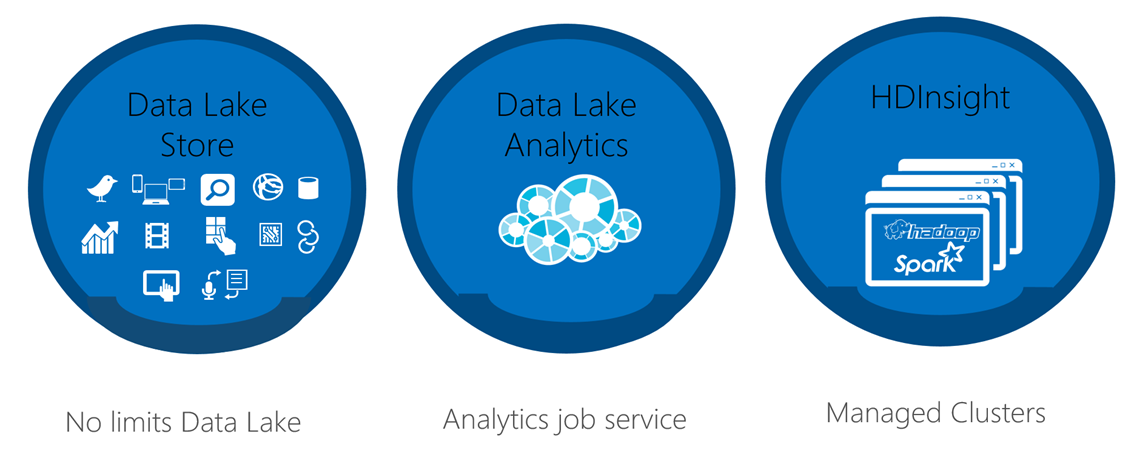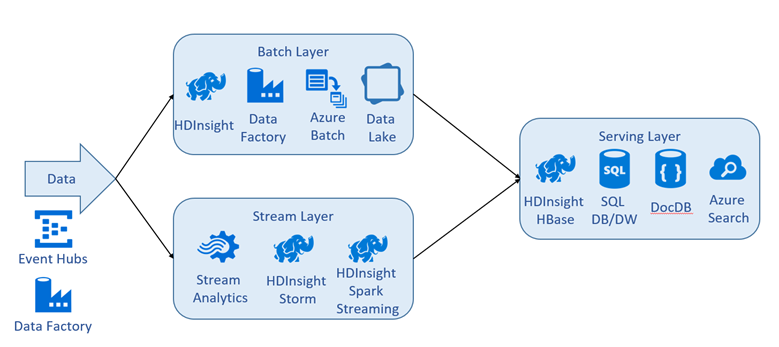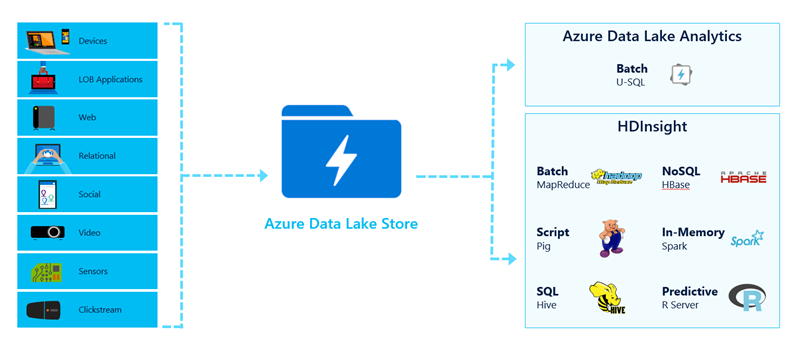
HDInsight

Reliable with an industry leading SLA
Enterprise-grade security and monitoring
Productive platform for developers and scientists
Cost effective cloud scale
Integration with leading ISV applications
Easy for administrators to manage
Resources & Hands on Labs for teaching
https://github.com/MSFTImagine/computerscience/tree/master/Workshop/7.%20HDInsight
Cluster Types available on Azure

Hadoop
Governed by the Apache Software Foundation
Core services: MapReduce, HDFS and YARN
Other functions across: data lifecycle and governance, data workflow, security, tools, data access and operations
MapReduce
Programming framework for analysing datasets stored on HDFS
Typically MapReduce + HDFS run on the same set of nodes
Distributes computation locally to where the data is
Scales linearly as you add nodes
Composed of used-supplied Map and Reduce functions:
Map(): subdivide and conquer
Reduce(): combine and reduce cardinality

Hive
SQL-like queries on data in HDFS
HiveQL = SQL-like languages
Hive structures include well-understood database concepts such as tables, rows, columns, partitions
Compiled into MapReduce jobs that are executed on Hadoop
Supports custom serializer/deserializers for complex or irregularly structured data
ODBC drivers to integrate with Power BI, Tableau, Qlik, etc.
HBase
NoSQL database on data in HDFS
random access and strong consistency for large amounts of unstructured and semistructured data in a schemaless database organized by column families
Can be queried using Hive
HDInsight implementation: automatic sharding of tables, strong consistency for reads and writes, and automatic failover
Storm
Stream Analytics for Near-Real Time processing
Consumes millions of real-time events from a scalable event broker: Apache Kafka, Azure Event Hub
Guarantees processing of data
Output to persistent stores, dashboards or devices
HDInsight implementation: Event Hub, Azure Virtual Network, SQL Database, Blob storage, and DocumentDB
Kafka
High-throughput, low-latency for real-time data
Stream millions of events per second
Enterprise-grade management and control
Resources & Hands on Labs for courses
https://github.com/MSFTImagine/computerscience/tree/master/Workshop/6.%20HPC%20and%20Containers
https://github.com/Microsoft/TechnicalCommunityContent/tree/master/Big%20Data%20and%20Analytics
Azure Data Lake
Petabyte size files and Trillions of objects
Scalable throughput for massively parallel analytics
HDFS for the cloud
Always encrypted, role-based security & auditing
Enterprise-grade support
Data Ingress & Egress –> To & From Azure Data Lake
Data can be ingested into Azure Data Lake Store from a variety of sources

Data can be exported from Azure Data Lake Store into numerous targets/sinks

Resources and Hands on Labs
https://github.com/Microsoft/TechnicalCommunityContent/tree/master/Big%20Data%20and%20Analytics
https://azure.microsoft.com/en-us/solutions/data-lake/
Azure Data Lake Analytics

Built on Apache YARN
Scales dynamically with the turn of a dial
Pay by the query
Supports Azure AD for access control, roles, and integration with on-premise identity systems
Processes data across Azure
Built with U-SQL to unify the benefits of SQL with the power of C#
U-SQL: a simple
and powerful language that’s familiar and easily extensibleUnifies the declarative
nature of SQL with expressive
power of C#Leverage existing libraries in .NET languages, R and Python
Massively parallelize code on diverse workloads (ETL, ML, image tagging, facial detection)
Resources
https://azure.microsoft.com/en-us/services/data-lake-analytics/
Architecture
Nathan Marz came up with the term Lambda Architecture (LA) for a generic, scalable and fault-tolerant data processing architecture, based on his experience working on distributed data processing systems at Backtype and Twitter.
The LA aims to satisfy the needs for a robust system that is fault-tolerant, both against hardware failures and human mistakes, being able to serve a wide range of workloads and use cases, and in which low-latency reads and updates are required. The resulting system should be linearly scalable, and it should scale out rather than up.
Here’s how it looks like, from a high-level perspective:

http://lambda-architecture.net/
Azure Data Architecture

Resources
https://channel9.msdn.com/Search?term=Big%20Data#pubDate=year&ch9Search&lang-en=en
 Microsoft
Microsoft